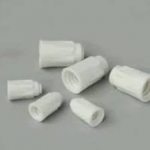Is the ampacity of a wire nut determined by the maximum wire size it's designed for?
Never really thought much of it until recently . I've gone on 2 service calls, one a j box connection feeding an electric welder and the other a j box connection for a fairly high wattage cooktop. Both instances I've found the wire nuts pretty much toast.Both were residential applications, both on 60 amp 2 pole breakers with #6 NM cable on both.
I routinely use Ideal blue wire nuts on all my oven and cooktop installs and have never knowingly had a problem.
Anybody still using split bolts for these connections?
Thoughts.
Never really thought much of it until recently . I've gone on 2 service calls, one a j box connection feeding an electric welder and the other a j box connection for a fairly high wattage cooktop. Both instances I've found the wire nuts pretty much toast.Both were residential applications, both on 60 amp 2 pole breakers with #6 NM cable on both.
I routinely use Ideal blue wire nuts on all my oven and cooktop installs and have never knowingly had a problem.
Anybody still using split bolts for these connections?
Thoughts.

